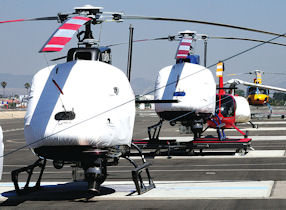For most Angelenos, it’s a way of life – the thump, thump, thump of helicopter noise. The helicopters might be hovering over an accident on the 405, buzzing a tourist landmark like the Hollywood sign, interrupting a concert at the Hollywood bowl to take a look, or covering the latest Justin Beiber egging incident. No matter when – they’re practically omnipresent. With Washington at a standstill due to partisan gridlock, it’s not often that much gets accomplished. But Congress recently broke through legislative stalemate and passed the 2014 Omnibus Appropriations bill to provide funding for essential services through the fiscal year. In it was an important provision to regulate helicopter noise in Los Angeles that Sen. Dianne Feinstein and I fought hard to include in the bill. With very few stand-alone bills passing due to gridlock, it was imperative we try all avenues. As technology has brought us into a digital-age, it has also led to an insatiable appetite for the latest footage of, well, everything. When helicopters hover over neighborhoods for hours on end or take a shortcut through a canyon, there is nobody to turn to, no laws that could even allow residents to complain or report the nuisances to authorities. Efforts to reduce helicopter noise began years ago with fed up residents tired of rattling windows and disrupted conversations. Frustrations over helicopter noise came to a head when helicopter operators offered tours to view the 405 Freeway during Carmageddon, and in 2011, then-Rep. Howard Berman, D-Sherman Oaks, and I introduced legislation to regulate helicopter noise in Los Angeles County. That bill, however, stalled in committee. Last year, I took up the legislation again, supported by Sens. Feinstein and Boxer, and six of my colleagues from the Los Angeles Congressional delegation. This bill, the Los Angeles Residential Helicopter Noise Relief Act, also stalled, but not from lack of support. There have been town hall meetings attended by hundreds of Angelenos vehemently in favor of regulating helicopter noise – oftentimes, if on cue, they were interrupted by helicopters overhead. Homeowners – determined to have a good night’s sleep – want restricted flight paths and minimum flight altitudes in the books. Helicopter pilots – fearful of having restrictions on their aerodynamic freedom –have opposed any and all forms of regulation or even a study on regulation. The Federal Aviation Administration, the government agency charged with safety and regulation of civil aviation, has also shown little interest in regulating noise and instead recommended voluntary noise-reduction measures in its May 2013 Report on the Los Angeles Helicopter Noise Initiative. Voluntary measures are not new. The Fly Neighborly program – a series of noise abatement techniques – was unfortunately not followed consistently and doesn’t do enough. Unless all helicopter pilots can commit fully to the success of voluntary measures, they have no chance of making much of a positive impact. The provision on helicopter noise that just passed directs the FAA to prove the effectiveness of self-recommended voluntary measures in the May 2013 report, and if the FAA is unable to do so, then it must issue regulations to address the problem. This language is an unmitigated positive for homeowners and residents. The FAA will have one year to implement effective voluntary measures, the helicopter industry will finally have an incentive to make voluntary measures work in order to avoid regulations, and – one way or the other – residents should finally get relief. And the provision will help create a centralized and comprehensive noise complaint system for the county that would allow residents to identify and report bad actors – something both residents and helicopter pilots support. Of course, if these voluntary measures don’t work, regulations will mandate relief. Helicopter pilots have argued time and time again that voluntary measures can work – they now have an opportunity to prove it. The FAA, helicopter industry and homeowners have been meeting regularly – in good faith – to work on solutions that work for everyone. From evaluating existing helicopter routes, developing best practices for helicopter hovering and news gathering and increasing awareness of noise-sensitive areas to helicopter pilots, to identifying a reporting system, the steps are many but the goal is simply to minimize the impact of helicopter noise on residential communities. I have met with law enforcement and public safety helicopter operators and they also have a role to play. They too have been actively participating in the regular meetings of stakeholders. While regulatory measures are unlikely to restrict public safety operations, emergency operators will be subject to any complaint system and have committed to being part of the solution. Los Angeles is among the most congested and complex airspace in the world, but that is no excuse for inaction. The provision passed by Congress should help ensure that relief is finally on its way. Rep. Adam Schiff, D-Burbank, is a member of the House Appropriations Committee and author of the Los Angeles Helicopter Noise Initiative.
